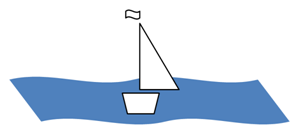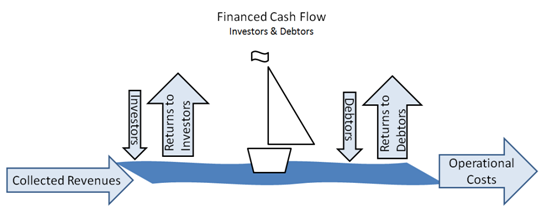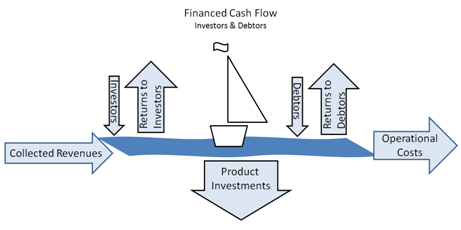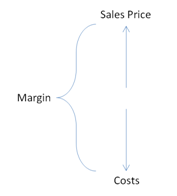Val Workman
The opinions expressed by the bloggers below and those providing comments are theirs alone, and do not necessarily reflect the opinions of Ryma Technology Solutions. As they say, you can't innovate without breaking a few eggs...
- Font size: Larger Smaller
- Hits: 22559
- 0 Comments
- Subscribe to this entry
- Bookmark
The Business of Product Management
Competitive advantage is at the heart of every product initiative. It surprises me how many Product Manager teams still can't trace their daily activities back to the increase of competitive advantage. In 2009, almost every product manager in the world had to find a way to justify their existence. Even today, there are some who cannot. So let's walk through this together.
The goal of product management is to increase your competitive advantage through product initiatives. We do this in two ways. We increase product differentiation (I will use the term "product" to cover products, services, and/or total offerings), and/or improve our cost-position. The common tension found here is that the more we spend on product initiatives, the more differentiated the product can become, but increased investments raise costs which worsens our cost-position relative to our competition's costs.

The Product management team must maintain a balance between these two factors of competitive advantage. Yes, there're times when a product initiative increases differentiation and improves the cost-position, and this should be sought, but, typically these two factors are in opposition of each other.
Product differentiation and customer-value are tightly related. Asking "How can a product management team increase differentiation?" is the same as asking "How can a product management team increase the perceived value of their product?". This is why having a market-driven innovation process is so important; it increases differentiation by building what the customer values. Increasing this factor will increase the amount of revenue gathered in a given month. This increased differentiation increases competitive advantage.
The product management team can also increase competitive advantage by improving their relative cost-position. When they can deliver the same products as their competitors' for less, they increase their own competitive advantage. This is accomplished by making their processes more effective and efficient, and by better utilizing resources and leveraging product assets. Improving your relative cost-position is the lowering of your operational expenses. This improved cost-position increases competitive advantage.
Let's look at this in a different way. Suppose your entire company could be represented by a boat. If your company is still in business, then it's floating on a river, a river of cash. This cash keeps your company floating. If there is ever not enough cash to keep your boat floating, then the boat sinks, and we say your company has gone out of business. If your company grows, then it needs a bigger boat. With a bigger boat, what has to happen to the size of the river if the boat is going to float?

Your right, the sides of the river must spread further apart to make room for the boat. The river may have to get deeper. It turns out that in all cases, if the boat gets bigger, the volume of the river must get bigger, we refer to this river volume, as cash flow. Without enough cash flow, your ship will sink.
Where does the cash come from that keeps your boat afloat? Right, collected revenues. All the while you’re collecting revenues and building volume, operational costs are sucking cash out of your river. This is called operational cash flow (OCF). As long as collected revenues are bigger than operational costs, your OCF is strong and it can hold up your boat.

Consider with me for a moment additional ways we could increase the volume of my river, or cash flow, other than through OCF. Well, there is financed cash flow or (FCF). The trouble with FCF, regardless of which type, investors or borrowed, you have to pay it back, and they'll want more cash than what they put in. So FCF works in short-term, but the river volume is not sustainable. Eventually, the cash flow will dry up, and your boat will sink if you haven't been able to reduce operational costs with the added money, and/or increase collected revenue.

Whatever you do with that FCF, it must impact the OCF at a greater rate than the returns your investors and debtors are demanding back. It's at this point that things can get interesting for the product management team. There are times the surpluses of OCF and/or FCF is used in Investing Cash Flow (ICF). ICF begins when companies invest surplus OCF in something like mergers, acquisitions or product initiatives to increase future OCF. The initial effect of ICF is a decrease in OCF because you’re diverting some of the river of cash into investments. The expectation is an increase in OCF at some future time.

The biggest complaint we hear about product management teams is the executive staff feels like they keep stuffing money down the product investment hole, and they can't see any difference in the levels of OCF. Consider the diagram I started with on competitive advantage. The business of product management becomes clearer. All product initiatives must increase the levels of collected revenue through better product differentiation, and/or increase the efficiency and effectiveness of operations.

Differentiation: Product management increases the perceived value of a product by adding features that the market values. This increases the value proposition of the product and allows for premium pricing. Higher prices may not be the strategy, but an increased competitive advantage is.
Cost-Position: Product management lowers costs through better practices that facilitate more effective and efficient decisions, better utilized resources, and an increase in leveraged assets.
The result of product management is wider margins, which when used correctly always means an increase in competitive advantage. This is what's meant when you hear that the product management team should work in the margins. I'll focus more on the margin in another posting.








